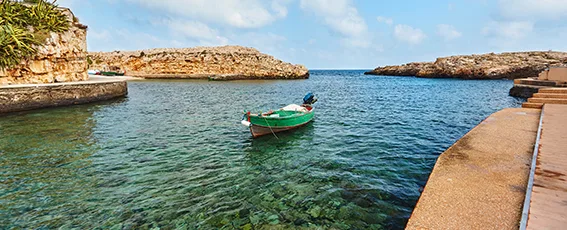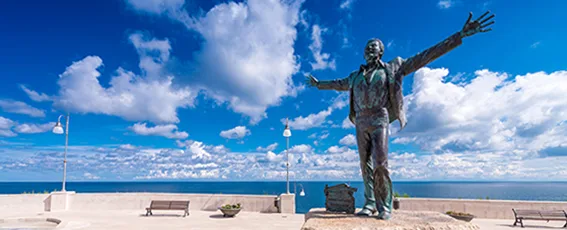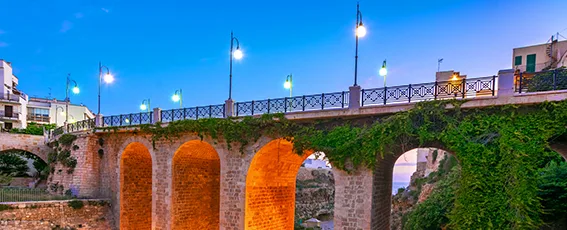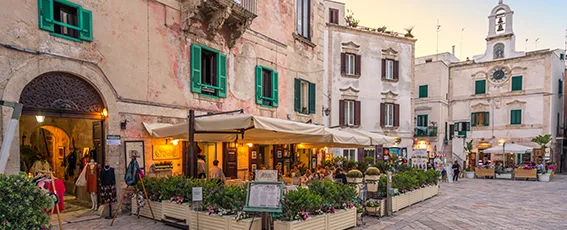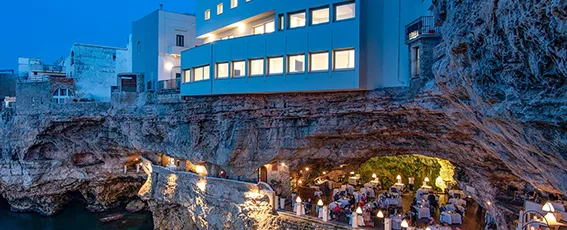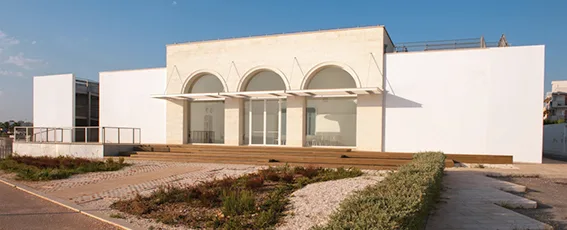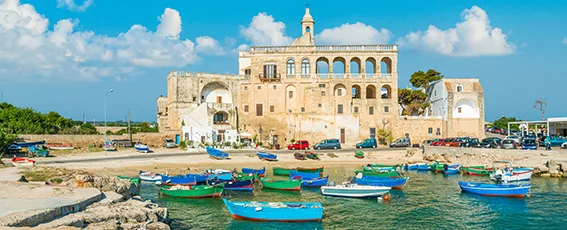STORIA
•
HISTORY
LUOGHI
•
PLACES
EVENTI
•
EVENTS
TRASPORTI
•
TRANSPORT
UTILITÀ
•
UTILITIES
LUOGHI • PLACES

Se avete programmato di sbalordire la vostra compagna o il vostro compagno con una proposta unica ed emozionante, o se volete sognare ad occhi aperti immergendo il vostro sguardo “nel blu dipinto di blu” allora Polignano a Mare è il luogo ideale da visitare. I suoi paesaggi mozzafiato e le sue incantevoli scogliere a strapiombo sull’acqua ne fanno di questo Paese arroccato sul mare, una chicca che vi lascerà senza parole. Arrivando a Polignano da Nord e fiancheggiando la costa adriatica si resta immediatamente rapiti dall’azzurro del mare, in contrasto con il bianco della roccia calcarea e il nero della scogliera, puntellata qua e là dalla vegetazione tipica della macchia mediterranea. Cala Paura è una delle spiagge più gettonate da abitanti e turisti.

If you have planned to amaze your partner or your partner with a unique and exciting proposal, or if you want to daydream by immersing your gaze “in the blue painted blue” then Polignano a Mare is the ideal place to visit. Its breathtaking landscapes and its enchanting cliffs overlooking the water make this country perched on the sea a gem that will leave you speechless. Arriving in Polignano from the north and flanking the Adriatic coast, one is immediately captivated by the blue of the sea, in contrast with the white of the limestone rock and the black of the cliff, dotted here and there by the typical vegetation of the Mediterranean scrub. Cala Paura is one of the most popular beaches for locals and tourists.

Dalle calette, percorrendo il lungomare verso il centro abitato, ci si imbatte in un signore baffuto a braccia aperte. Siamo a Largo Gelso, dove dal 2009 troviamo la statua di Domenico Modugno, in bronzo e alta circa 3 metri, ideata e realizzata dallo scultore argentino Hermann Mejer. Inaugurata il 31 maggio del 2009, la statua di bronzo è alta circa 3 metri, ideata e realizzata dallo scultore argentino Hermann Mejer, già autore di altre opere in Italia e all’estero. La scultura è un abbraccio del grande Mimmo al suo paese d’origine: la statua è, infatti, rivolta verso il borgo, come intento a intonare la famosa “Volare”, brano con cui raggiunse l’apice del successo nel Sanremo 1958.

From the coves, along the seafront towards the town, you come across a mustachioed gentleman with open arms. We are in Largo Gelso, where since 2009 we have found the statue of Domenico Modugno, in bronze and about 3 meters high, designed and built by the Argentine sculptor Hermann Mejer. Inaugurated on May 31, 2009, the bronze statue is about 3 meters high, designed and built by the Argentine sculptor Hermann Mejer, already the author of other works in Italy and abroad. The sculpture is an embrace of the great Mimmo to his country of origin: the statue is, in fact, facing the village, as if intent on intoning the famous “Volare”, a song with which he reached the apex of success in Sanremo 1958.

Si entra così nel centro storico per mezzo di un antico ponte romano, sul cui selciato si conserva un piccolo tratto della storica via Traiana usata dai Romani.
Il ponte domina imponente sulla lama Monachile, letto di corso d’acqua ormai prosciugato che ne fa di questo luogo uno dei più affascinanti, sia di giorno sia di notte, da cui “bearsi e godere” dell’abbraccio del mare e della brezza marina e ammirare un panorama da togliere il fiato.

Thus you enter the historic center by means of an ancient Roman bridge, on whose pavement a small section of the historic Via Traiana used by the Romans is preserved.
The bridge dominates imposingly on the Monachile blade, a river bed now dried up which makes this place one of the most fascinating, both day and night, from which to “bask and enjoy” the embrace of the sea and the sea breeze and admire a breathtaking panorama.

Oggi Polignano si presenta ai turisti e ai visitatori come una piccola cittadina ricca di fascino e storia. Delle epoche passate sono rimasti molti simboli e segni tangibili: l’Arco Marchesale, ingresso del borgo antico, è stata la porta d’ingresso della città fino al 1780. Lasciati trasportare nel “labirinto” di strade e viuzze tutte diverse tra di loro e tutte ricche di particolari.

Today Polignano presents itself to tourists and visitors as a small town full of charm and history. Many symbols and tangible signs have remained from past eras: the Marchesale Arch, entrance to the ancient village, was the gateway to the city until 1780. Let yourself be transported into the “labyrinth” of streets and alleys, all different from each other and all rich in details.

La più grande delle 80 grotte naturali che squarciano la costa rocciosa di Polignano, Grotta Palazzese è “l’opera finale” naturale del vento e del mare che con la loro azione erosiva negli anni hanno disegnato e modellato due incredibili aperture naturali all’interno delle quali si trova una grande volta calcarea. Citata nell’ enciclopedie di Diderot e D’Alembert, immortalata dal famoso pittore e architetto francese Louis Jean Desprez nel 1778, si narra che la regina Giovanna I d’Angiò durante la sua visita in Puglia, affascinata dalla bellezza di questo luogo si concesse qualche ora di passione e d’amore con il suo terzo sposo. Rimane oggi uno dei luoghi più affascinanti da visitare per vivere una serata romantica e in dolce compagnia.

The largest of the 80 natural caves that pierce the rocky coast of Polignano, Grotta Palazzese is the natural “final work” of the wind and the sea which with their erosive action over the years have designed and modeled two incredible natural openings inside the which there is a large limestone vault. Mentioned in the encyclopedias of Diderot and D’Alembert, immortalized by the famous French painter and architect Louis Jean Desprez in 1778, it is said that Queen Giovanna I of Anjou during her visit to Puglia, fascinated by the beauty of this place, allowed herself some hour of passion and love with her third spouse. Today it remains one of the most fascinating places to visit to experience a romantic evening in sweet company.

Proseguendo lungo Largo Ardito, “teatro all’aperto” e spesso location di manifestazioni e spettacoli, si giunge presso il lungomare Cristoforo Colombo che costeggia la scogliera in lungo e in largo e che ci permette di giungere al museo d’Arte Contemporanea Pino Pascali. Pino Pascali, artista ecclettico, scultore e scenografo è sicuramente insieme al grande Domenico Modugno il personaggio storico più importante di Polignano a Mare ed è considerato uno dei più importanti esponenti dell’arte povera. Le sue opere sono esposte in tutta Italia e anche in alcuni dei più importanti musei al Mondo come il MoMa di New York o il Pompidou di Parigi.

Continuing along Largo Ardito, “open-air theater” and often the location of events and shows, we arrive at the Cristoforo Colombo promenade which runs along the cliffs far and wide and which allows us to reach the Pino Pascali Museum of Contemporary Art. Pino Pascali, an eclectic artist, sculptor and set designer, is certainly the most important historical figure of Polignano a Mare together with the great Domenico Modugno and is considered one of the most important exponents of poor art. His works are exhibited throughout Italy and also in some of the most important museums in the world such as the MoMA in New York or the Pompidou in Paris.

A 3 Km di distanza sempre proseguendo in direzione Bari, si arriva a San Vito, frazione di Polignano a mare abitata soprattutto durante il periodo estivo, un piccolo borgo costiero di origine greca dove tuttora c’è un’insenatura naturale utilizzata sin dal passato come porticciolo per le barche dei pescatori locali. A dominare uno splendido scenario dal punto di vista paesaggistico-naturalistico unico, il complesso monastico benedettino composto dall’Abbazia e dalla Chiesa. Nonostante gli anni e i notevoli rimaneggiamenti sia la Chiesa che l’Abbazia conservano l’aspetto originale del tempo ed è stata per anni rifugio e punto d’accoglienza per i milioni di pellegrini e fedeli che solcavano il mare e approdavano sulle coste polignanesi per chiedere l’intercessione di San Vito martire.

At 3 km away, always continuing towards Bari, you arrive in San Vito, a hamlet of Polignano a mare inhabited especially during the summer period, a small coastal village of Greek origin where there is still a natural inlet used since the past as small port for local fishermen’s boats. Dominating a splendid scenery from a unique landscape-naturalistic point of view, the Benedictine monastic complex consisting of the Abbey and the Church. Despite the years and the notable alterations, both the Church and the Abbey retain the original appearance of the time and for years it has been a refuge and welcome point for the millions of pilgrims and faithful who sailed the sea and landed on the Polignano coasts to ask for the intercession of San Vito martyr.

